Physical Address
304 North Cardinal St.
Dorchester Center, MA 02124
Physical Address
304 North Cardinal St.
Dorchester Center, MA 02124
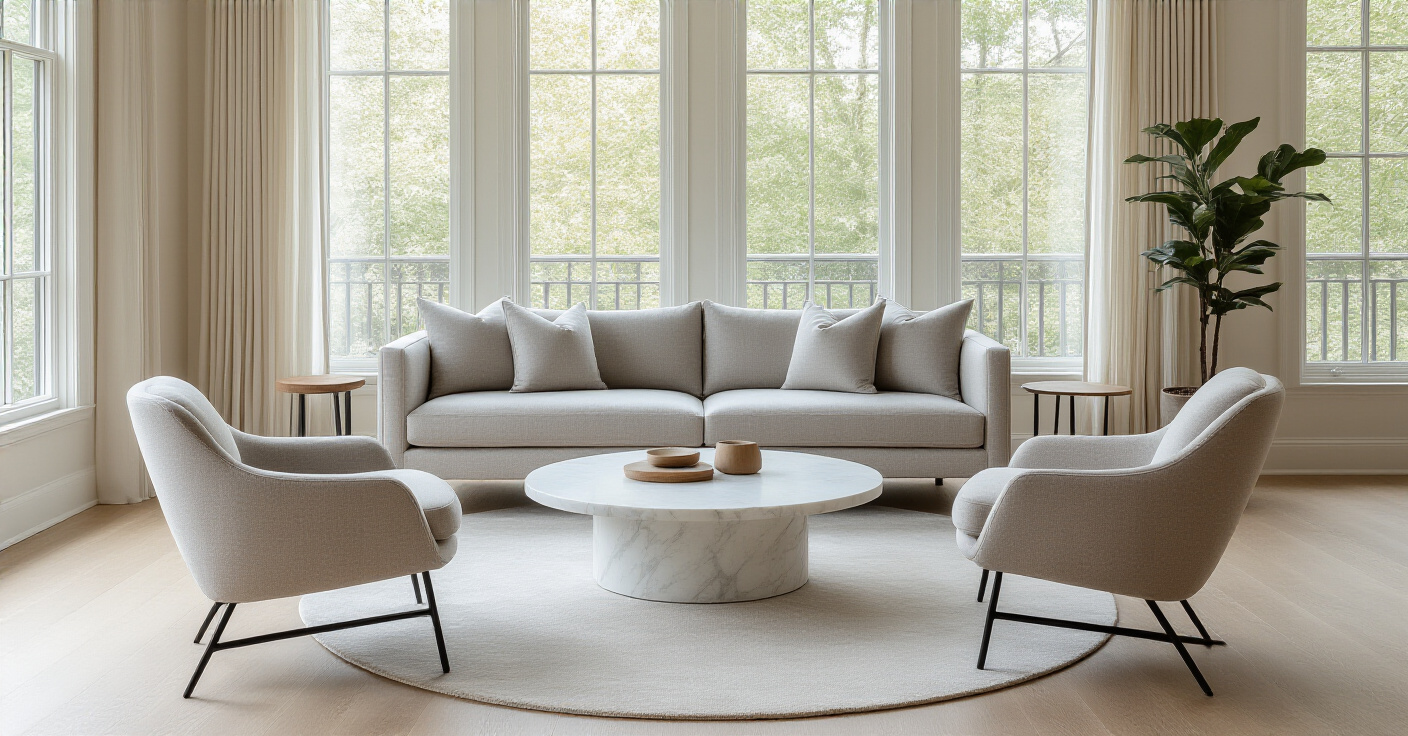
Master your modern living room decor with 23 expert tips. Learn to plan layouts, choose timeless furniture, layer lighting, integrate smart tech, and add personal style for a chic, functional space.
You know what people always ask me? It’s not about the latest smart gadget or the “it” color of the year. It’s some version of, “James, where do I even start?” They see these perfect, minimalist living rooms online and get completely paralyzed. They’re smart people—doctors, coders, entrepreneurs—but they’re terrified of spending a ton of money only to end up with a room that feels cold, boring, or just… wrong.
And that fear is real. I once watched a client try to “fix” their living room by buying an entire matching furniture set from a catalog. It was expensive, and the result was a space with zero personality. It looked like a hotel lobby, not a home. They were trying to follow rules they didn’t understand. So, forget the corporate speak and the overwhelming design blogs. Here’s what actually matters, what’s just noise, and the shortcuts I wish someone had given me years ago.
This is the phase everyone wants to skip. We all want to get to the fun part of picking out sofas and art. But I’m telling you, 90% of design mistakes happen right here, before a single dollar is spent. Nailing the plan isn’t boring; it’s your insurance policy against a living room you’ll hate in six months. Think of this as creating the blueprint for a space that not only looks incredible but also works effortlessly for your actual life.
Before you open a single browser tab for furniture, you need a North Star. What does “modern” actually mean to you? Is it the warm woods and clean angles of Mid-Century Modern? The stark, almost monastic vibe of pure Minimalism? Or the industrial feel of a Soho loft with concrete and metal? Most people skip this and just start buying things they like, and they end up with a collection of cool stuff that looks chaotic together.
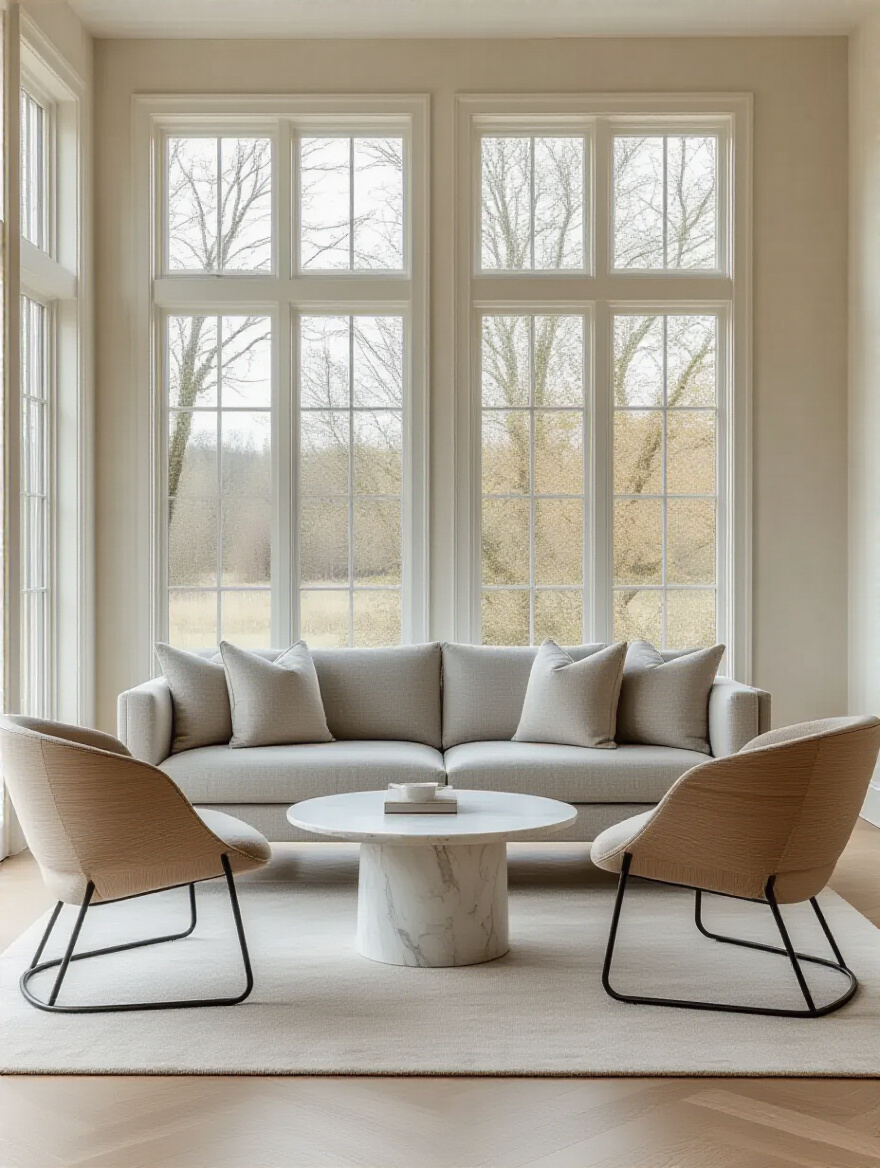
Defining your aesthetic is your filter. It’s the simple question you ask before you buy anything: “Does this fit my ‘Warm Minimalist’ vibe?” If the answer is no, you don’t buy it, no matter how much you like it. This single step saves more time, money, and regret than any other. Create a Pinterest board, but be ruthless. Once you see a pattern in what you’re pinning—say, clean lines, natural textures, and a neutral palette—delete everything that doesn’t fit. That’s your vision.
Now that you have a vision, let’s talk about the physical space it’s going to live in.
Your living room isn’t a museum exhibit; it’s a place you have to walk through a dozen times a day. Flow is everything. Before you move or buy a single thing, think about the paths you take. Where do you walk from the door? How do you get to the window? Are you constantly squeezing past the coffee table? That’s bad flow, and it creates a low-grade, constant friction in your life.
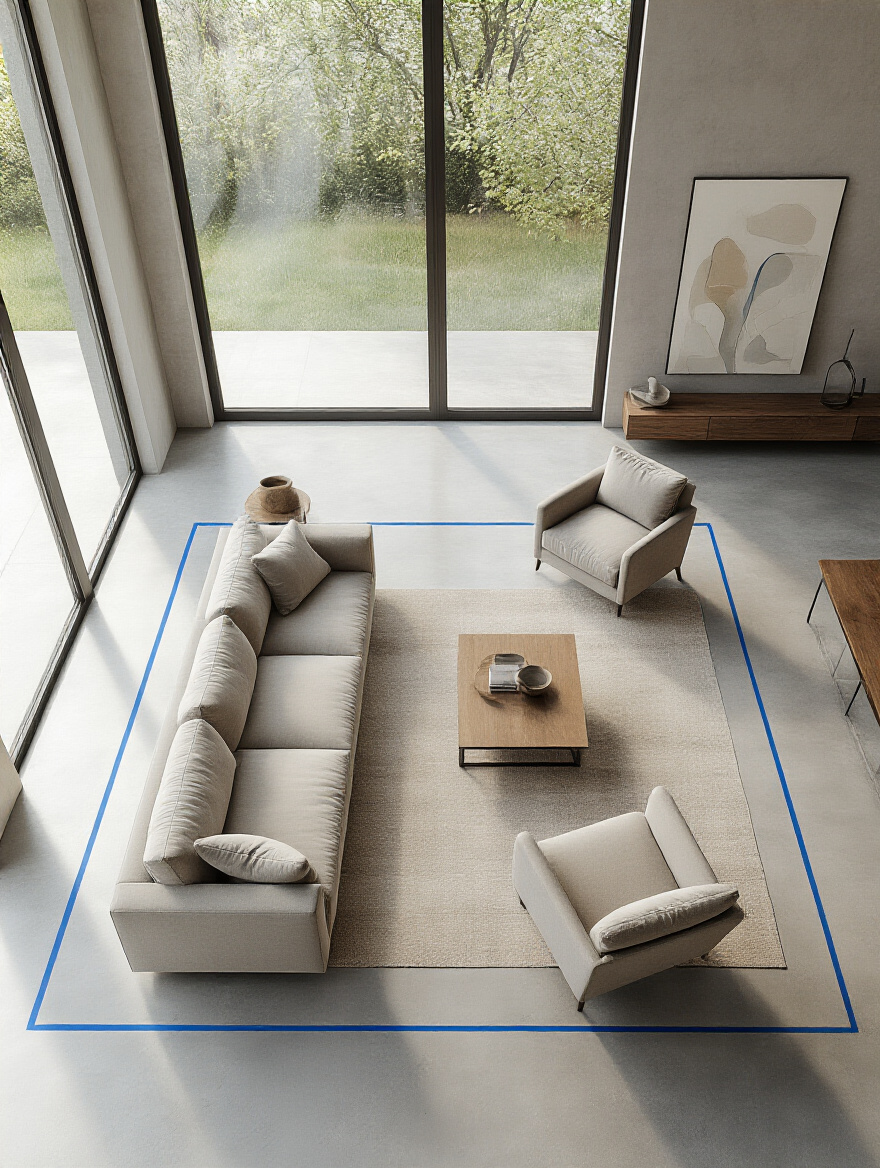
Grab a roll of painter’s tape and mark out where furniture could go on the floor. See how it feels to walk around it. This is a five-dollar trick that can save you from a five-thousand-dollar mistake, like buying a giant sectional that turns your living room into an obstacle course. You’re mapping out zones for conversation, for relaxing, for traffic. This ensures your room is designed for humans, not just for Instagram.
This practical, on-the-ground mapping is the first step, but we can make it even more foolproof with a digital version.
Okay, a “mood board” sounds a little artsy, but hear me out. A digital mood board is your visual safety net. It’s where you can see if that velvet green sofa actually works with the walnut media console and the abstract art you love before you enter your credit card information. It’s a low-stakes sandbox to test out your big ideas and see how they play together.
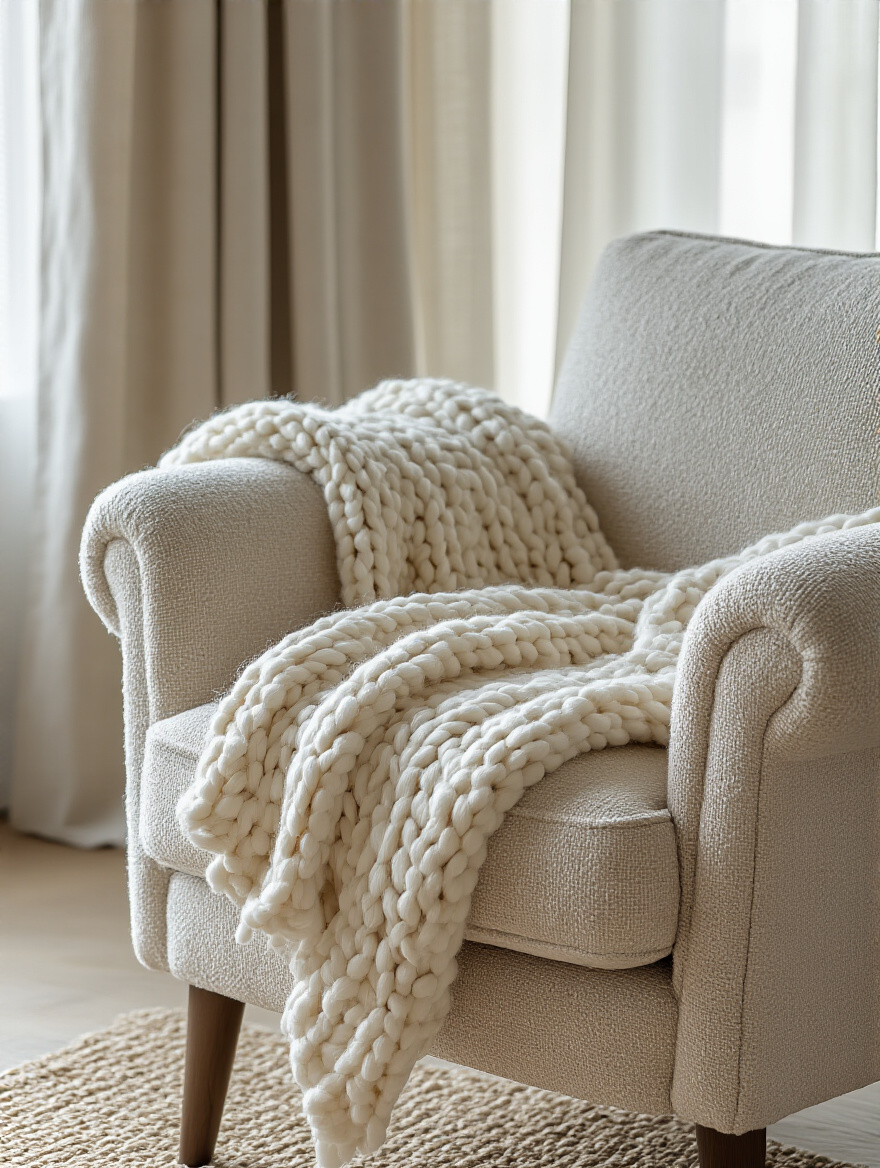
Use a simple tool like Pinterest or Canva. Pull in images of the exact sofa you’re considering, the rug, the coffee table, the paint color. See them all in one place. You’ll instantly spot what works and what clashes. I had a client who was about to buy a very expensive, very bold rug. On the mood board, it screamed for attention and made the whole room feel frantic. We swapped it for a textured neutral rug, and suddenly, everything else in the room could breathe. The mood board saved them from a huge, costly mistake.
Once you have your vibe locked in, it’s time to create the perfect canvas for it.
Modern design is really about subtraction. It’s about letting go of what isn’t essential so the things that are can have an impact. You can’t have a modern living room if it’s filled with clutter. Period. It doesn’t matter how beautiful your furniture is; if it’s swimming in a sea of trinkets, old magazines, and random cables, the design is completely lost.
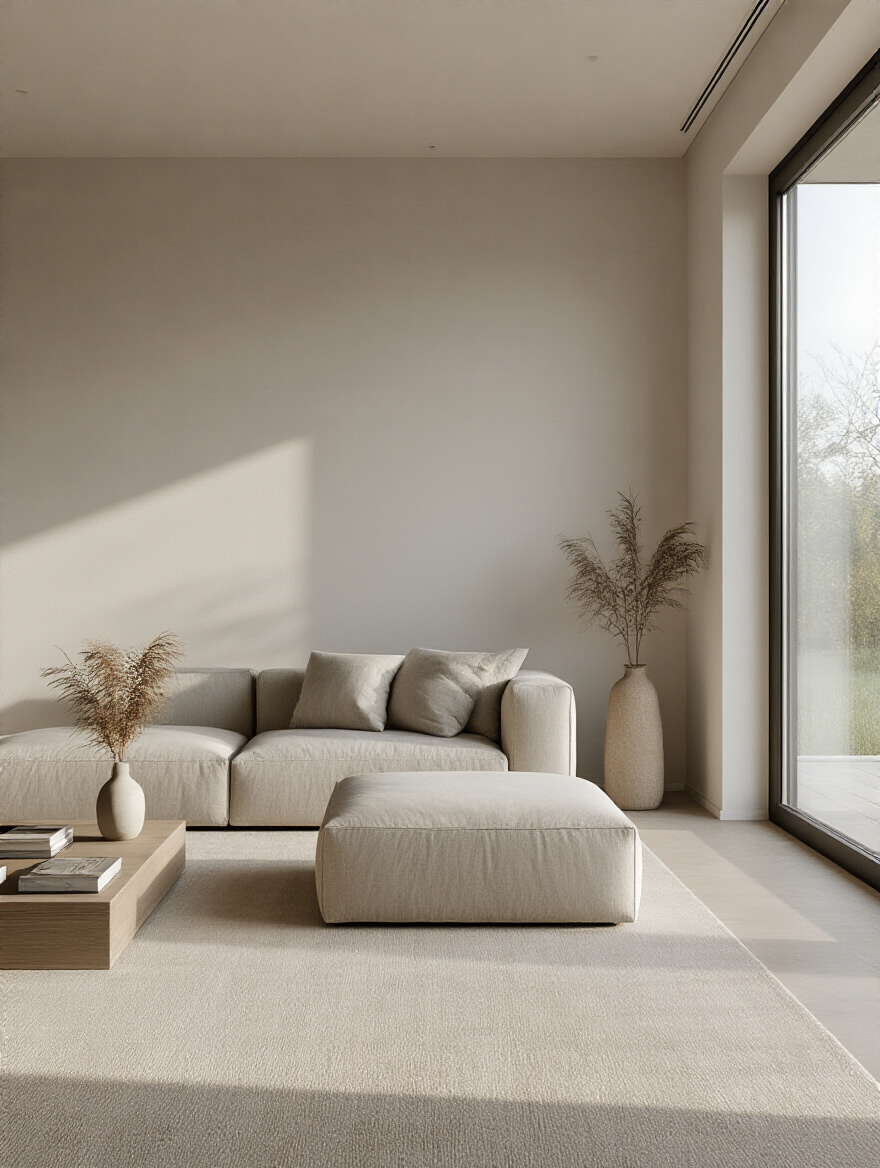
So, be ruthless. This isn’t just tidying up. This is a full-on edit of your space. The biggest lie people tell themselves is that they’ll get organized after they redecorate. It never works. Declutter first. Create a clean, blank slate. This act alone will make your space feel bigger, calmer, and more modern before you even start. Plus, it shows you what you actually need to store, so you can plan for smart, hidden storage instead of just buying more shelves to hold more junk.
With a clean slate and a clear vision, we can now make a couple of big, foundational decisions that will define the entire feel of the room. Getting these right is like setting the first row of dominoes. Everything else will just fall into place with so much more ease.
People get really stressed about color, but there’s a simple formula that pros use: the 60-30-10 rule. 60% of your room should be a dominant, neutral color (like the walls and sofa). 30% is a secondary neutral or texture (think rugs, chairs, curtains). The last 10% is your accent color—the fun stuff. This is where you bring in that pop of color with pillows, art, or a cool vase.
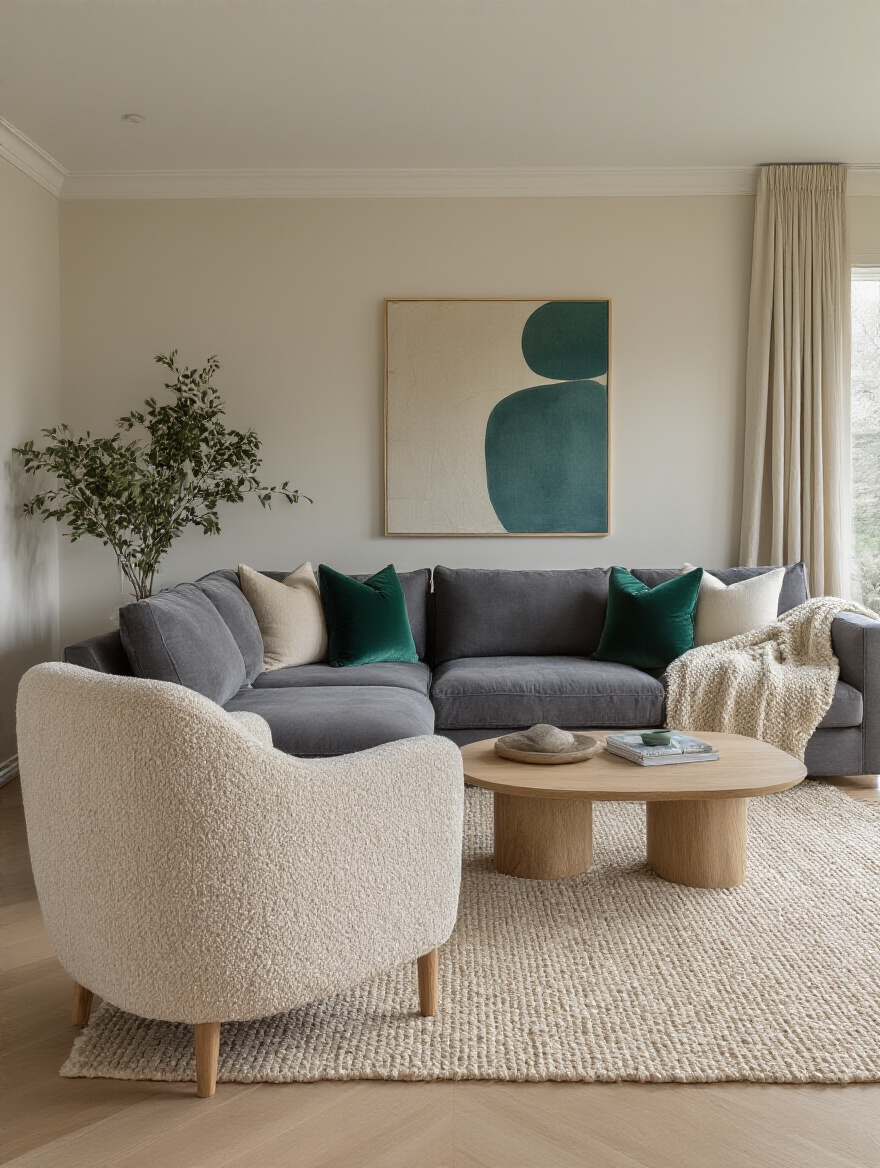
This framework is your best friend because it prevents you from making the room too chaotic or too boring. The neutrals create a calm, sophisticated backdrop, which makes that 10% of color feel intentional and powerful. It’s the difference between a room that feels thoughtful and a room that feels like a paint store exploded. And best of all? When you get tired of your accent color, you only have to change 10% of your room to get a whole new look.
Once the colors are set, we decide where they—and the furniture—will live.
Can we just agree to stop pushing all our furniture against the walls? It’s the number one thing people do, and it often makes a room feel like a waiting room. Pulling your sofa even just a few inches off the wall creates breathing room and makes the space feel larger and more intentional. The goal is to create conversational groupings that feel intimate and connected.
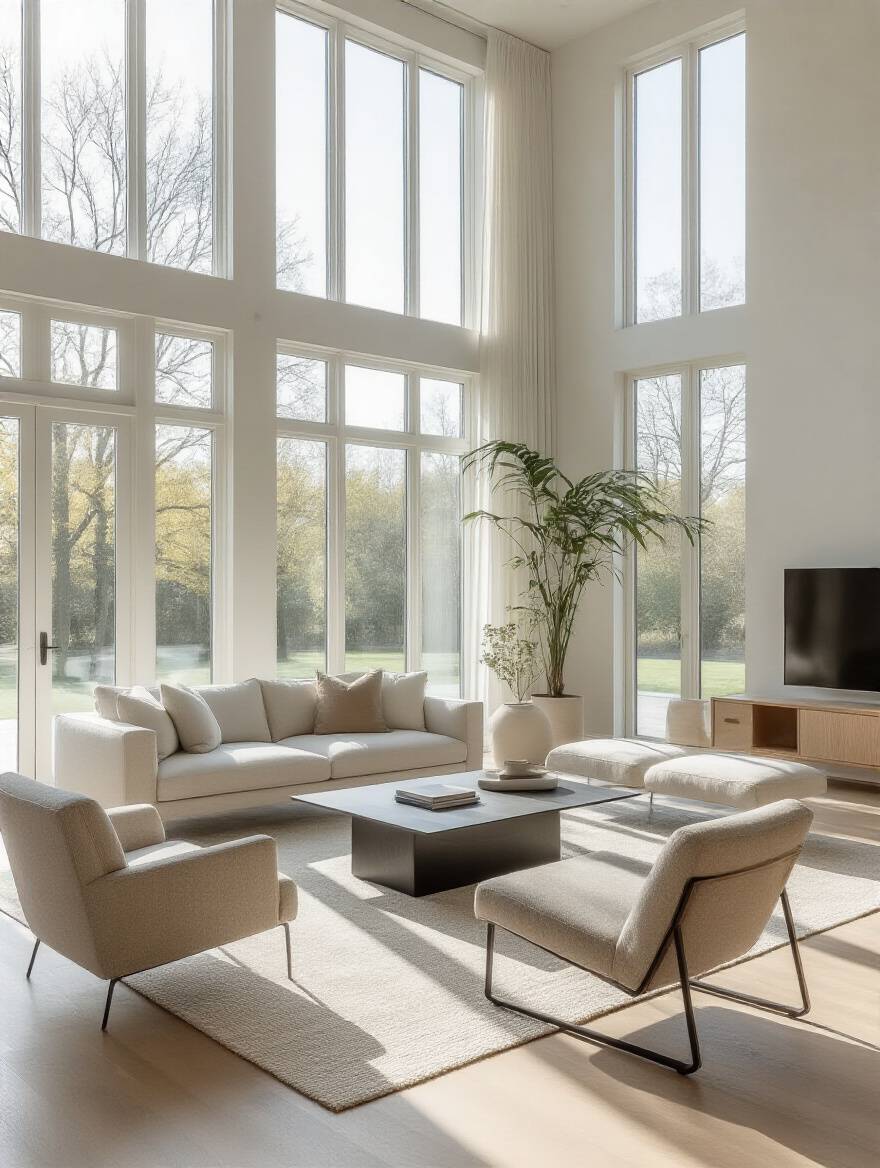
The empty space—what designers call “negative space”—is just as important as the furniture itself. It directs traffic, gives your eyes a place to rest, and keeps the room from feeling cramped. Think about creating a “float”—where your main seating arrangement floats in the middle of the room, anchored by a rug. This single move can completely transform the feel of your living room from static and flat to dynamic and inviting.
Alright, the planning is done. Now for the main event: choosing the core pieces that will be the workhorses of your living room. This is where you want to spend your money wisely, investing in quality pieces that will form the backbone of your design for years to come.
These three pieces are the holy trinity of your living room. They are the anchors. If you’re going to splurge anywhere, this is it. Think about it: your sofa is where you’ll spend hundreds of hours. It needs to be comfortable, durable, and something you love looking at. The same goes for your main chairs. Get these three things right, and everything else is just details.
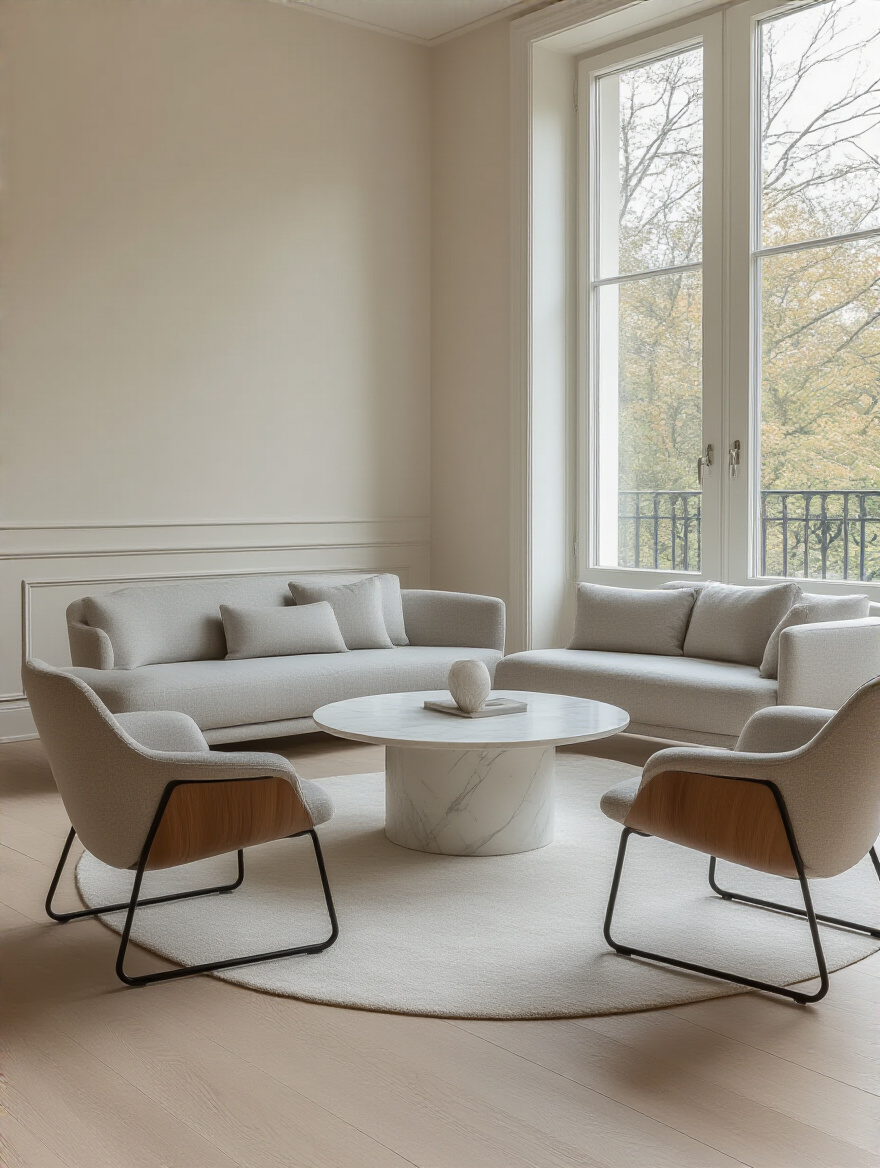
Don’t fall for fast-fashion furniture here. A cheap sofa will look lumpy and sad in two years. A well-made sofa with a solid wood frame and quality fabric will look great for a decade. Focus on clean lines and timeless shapes. A simple, beautifully-proportioned sofa will never go out of style. It’s the perfect canvas you can dress up or down with pillows and throws as trends change.
From the foundational pieces, we move to the secret weapons of modern design.
Unless you live in a palace, your space has to work hard. Multi-functional furniture isn’t a compromise; it’s just plain smart. Think of it as embedding technology into your furniture. An ottoman that opens up to store blankets. A coffee table with a top that lifts up to become a perfect work-from-home desk. A sleek media console that hides all your cables and clutter.
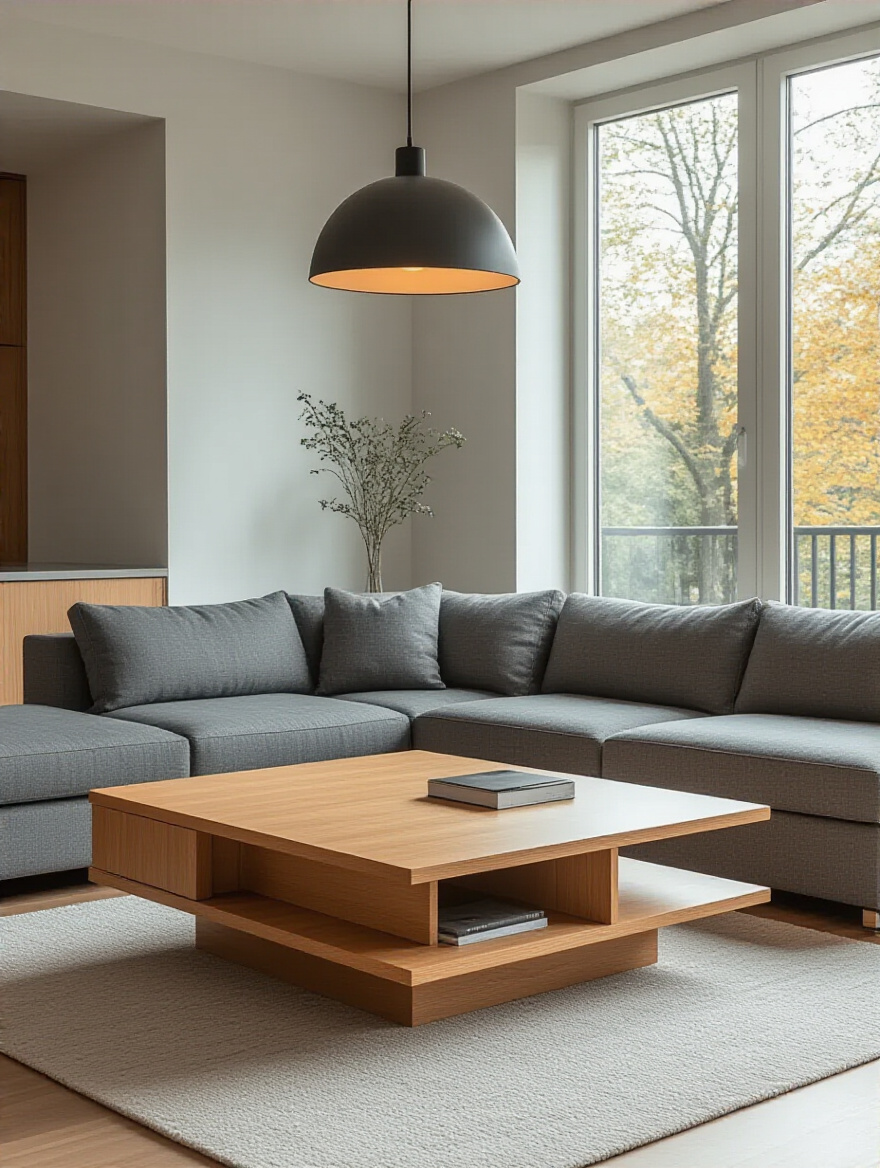
This is how you maintain a clean, minimalist look without having to live like a monk. You can have your stuff; it just doesn’t need to be on display 24/7. When you’re designing for a modern home, especially in a city, every square inch counts. These pieces allow a single room to serve multiple purposes without looking cluttered. It’s about making your furniture work smarter, not harder.
The function is crucial, but let’s not forget how a room feels to the touch.
A room with all flat, smooth surfaces can feel sterile and cold, no matter how perfect the design. Texture is the secret ingredient that adds warmth, depth, and a layer of luxury. The best part? It doesn’t add visual clutter. You can stick to a completely neutral color palette, but by mixing different textures, the room will feel rich and interesting.
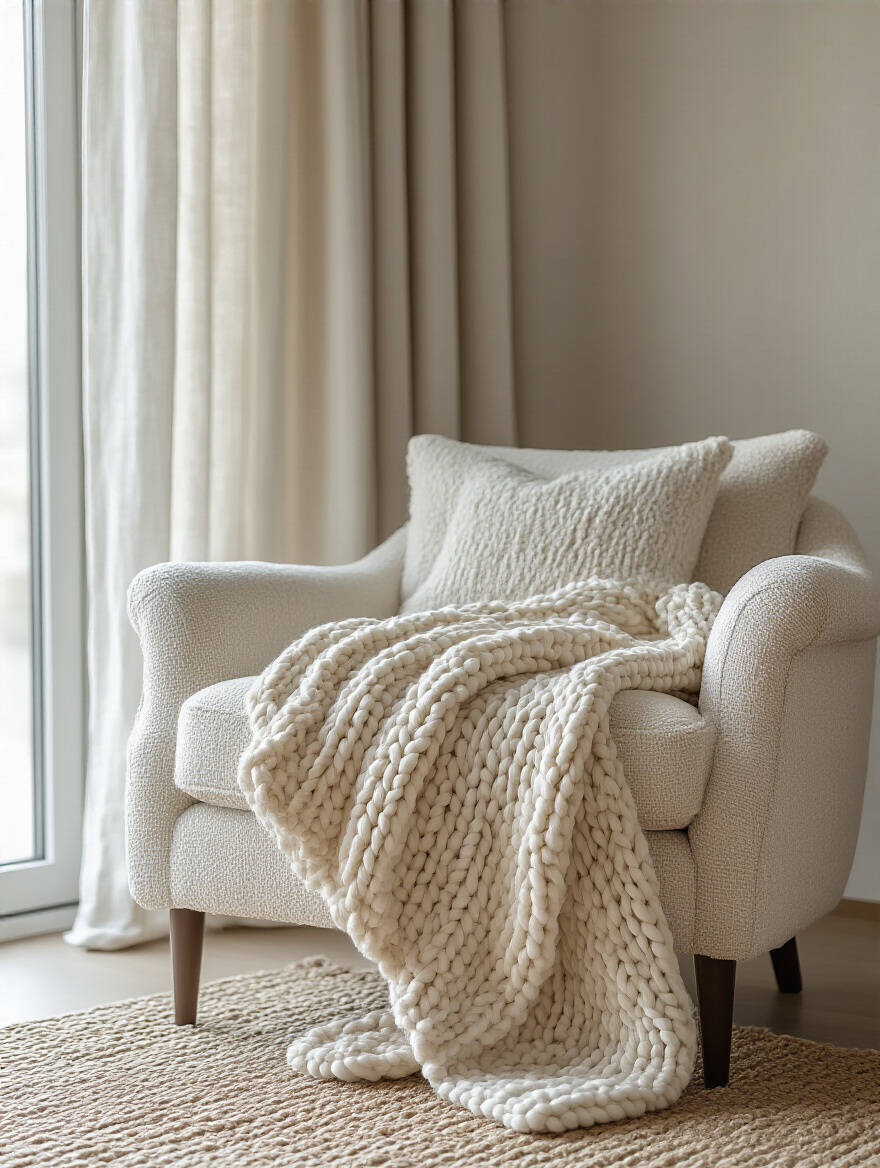
Think about a smooth leather chair next to a chunky knit throw, with a soft linen sofa and a rough-hewn jute rug. Each material catches the light differently and feels different to the touch. This sensory variety is what makes a room feel inviting and cozy. It’s how you make minimalism feel human. You’re giving the eye—and the hand—plenty to explore without adding a single overwhelming pattern or color.
Next, we’ll talk about the underlying “grammar” that holds all of these modern elements together.
Modern design has a clear language, and its core grammar is built on clean lines and strong geometric shapes. This is what creates that feeling of calm order and sophistication. Your sofa should have a simple, straight silhouette. Your coffee table might be a perfect circle or a sharp rectangle. Your shelving is linear and uncluttered.
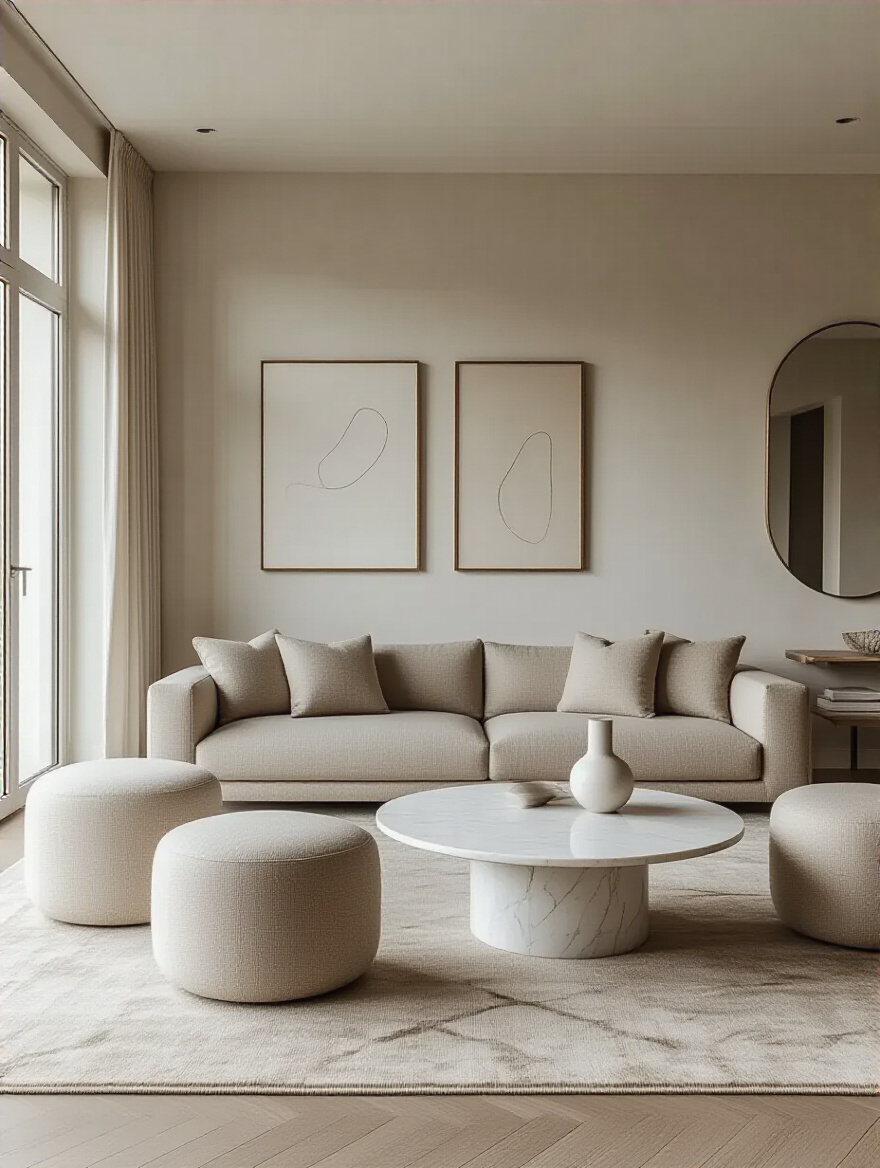
This doesn’t mean everything has to be a boring square. It’s about finding beauty in the form itself, without a lot of extra ornamentation. Look for furniture where the structure is the star. These simple, confident shapes provide a serene backdrop that allows your textures, your art, and your personal touches to stand out. It’s the disciplined foundation that makes the rest of your creative choices feel intentional.
We’ve built the foundation with key furniture pieces and a clear design language. Now, let’s bring in the elements that ground the space and tie everything together. These are the details that separate a nice room from a truly stunning one.
Modern design can sometimes lean a little cold, especially with all those clean lines. The antidote is natural materials. Wood, stone, and metal are essential for grounding a room and giving it a soul. A beautiful wood coffee table, a marble-topped side table, or the warm gleam of brass accents add organic texture and a connection to the natural world.
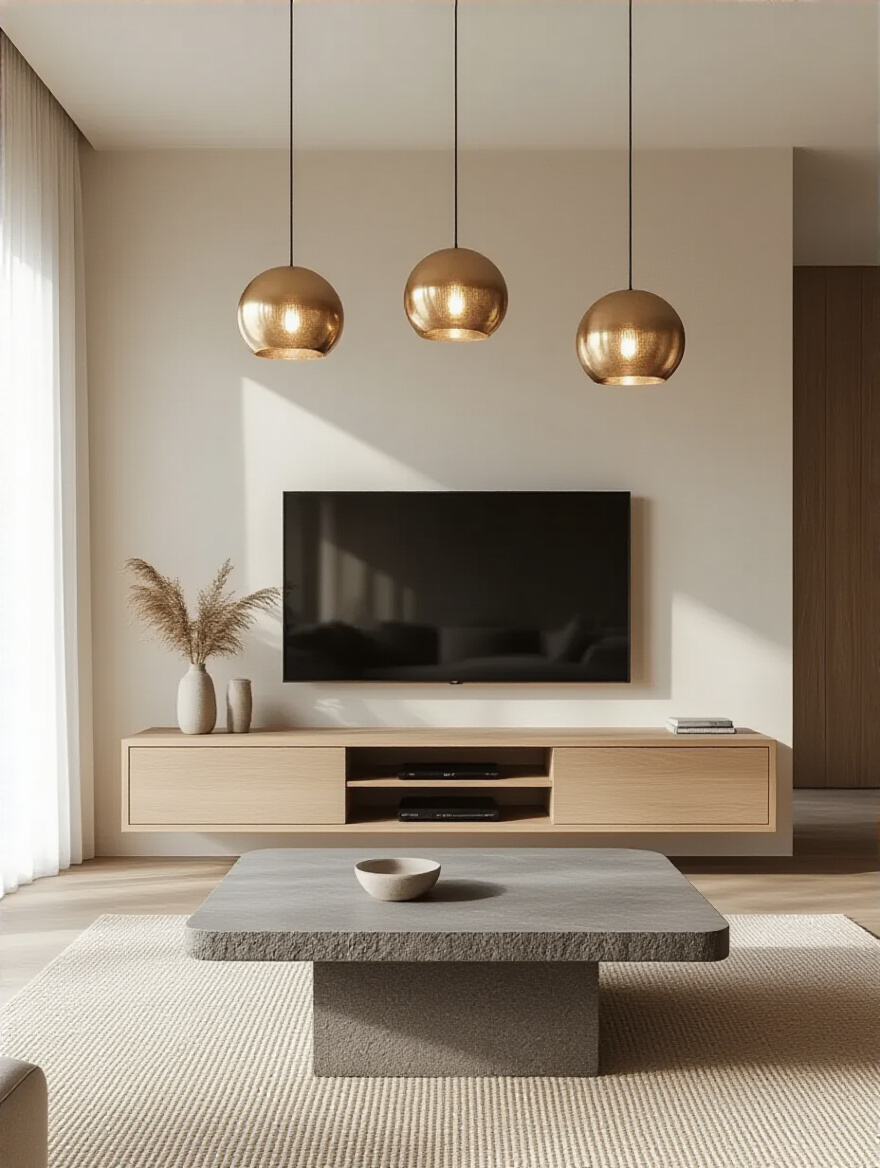
These materials have a timeless quality that fast-fashion decor just can’t replicate. They age gracefully and add a sense of authenticity and permanence to a space. You don’t need a lot. Just a few thoughtfully placed pieces can create a beautiful contrast with the sleeker elements in the room. This balance between the sleek and the organic is the hallmark of sophisticated modern design.
And speaking of grounding, nothing does it better than the piece that sits right under your feet.
An area rug is one of the most powerful tools in a designer’s arsenal. It’s not just decoration; it’s an architectural element. It defines a space, creates a “zone” for conversation, and anchors your furniture so it doesn’t look like it’s just floating aimlessly. A living room without a rug often feels unfinished and disconnected.
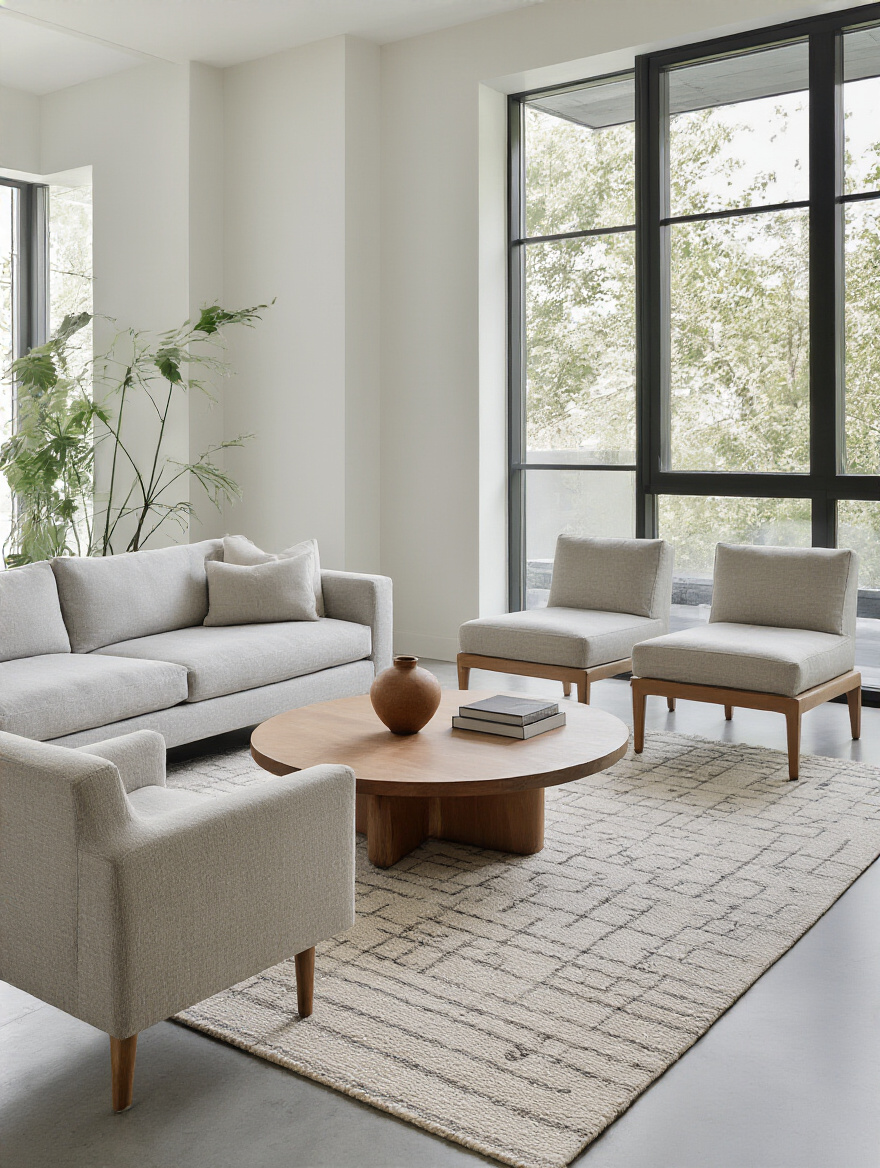
The biggest mistake people make is buying a rug that’s too small. It looks like a postage stamp in the middle of the floor. As a general rule, at least the front legs of your sofa and all your chairs should be sitting on the rug. This pulls the whole seating arrangement together into a cohesive unit. A rug is also a fantastic opportunity to add texture and warmth, especially on hardwood or tile floors.
With the big pieces in place, it’s time to layer in the elements that control the mood and bring your personality to the forefront. This is where a room really comes to life and starts to feel uniquely yours.
Please, I’m begging you, do not light your entire living room with a single, harsh ceiling light. I call that “interrogation lighting.” Great design requires layered lighting. You need three types: Ambient (the overall light from ceiling fixtures or recessed lights), Task (focused light for activities, like a reading lamp next to a chair), and Accent (light that highlights something specific, like art or a cool architectural feature).
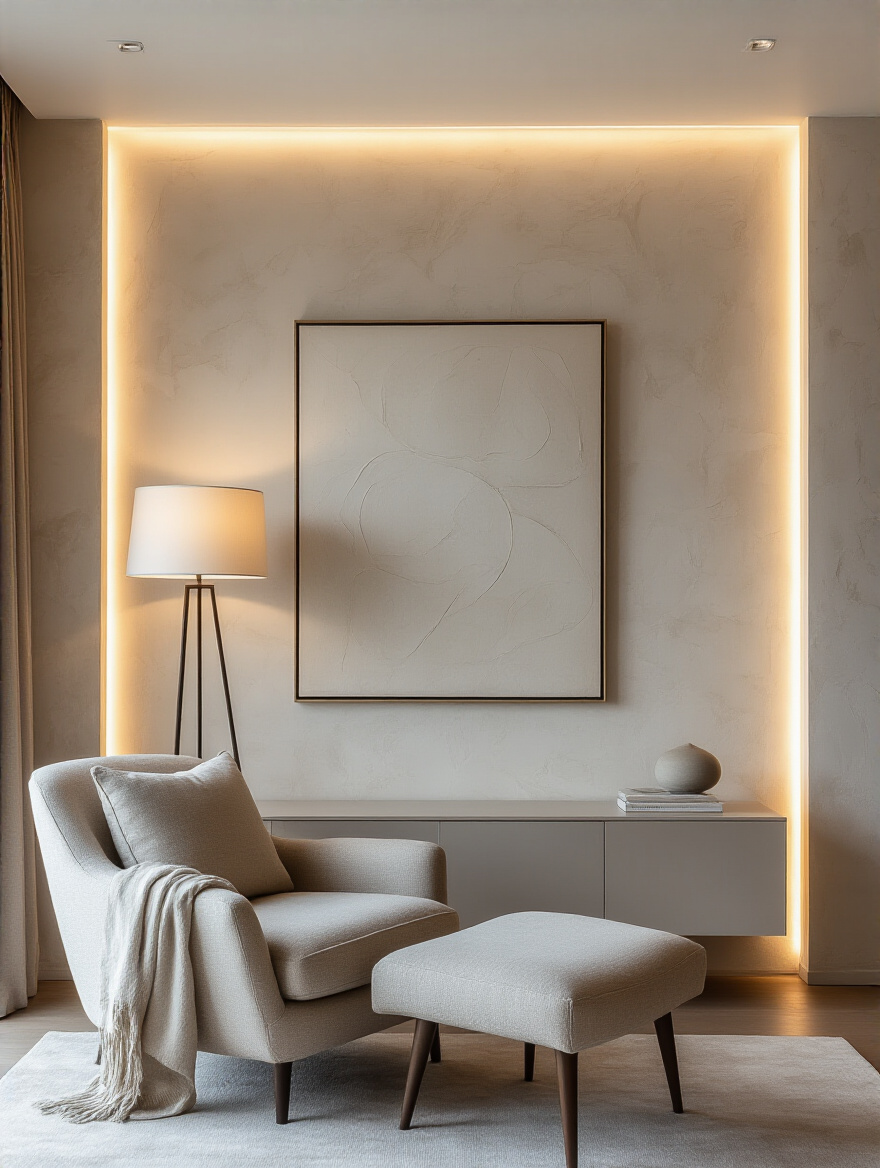
This is a perfect place to integrate smart tech seamlessly. Putting all these layers on dimmers—or even better, connecting them to a smart home system—is a game-changer. You can create “scenes” with the touch of a button or a voice command. A “Movie Night” scene might dim the overhead lights and turn on a soft accent lamp. A “Reading” scene powers up your task lamp. This allows your room to adapt its mood perfectly to whatever you’re doing.
And just like light, another element brings a space to life in a very literal way.
A room without plants is a room that’s missing something vital. Greenery is the easiest and most affordable way to add life, color, and natural, sculptural forms to a modern space. A tall Fiddle Leaf Fig can provide incredible verticality and drama, while a trailing Pothos can soften the hard edges of a bookshelf.
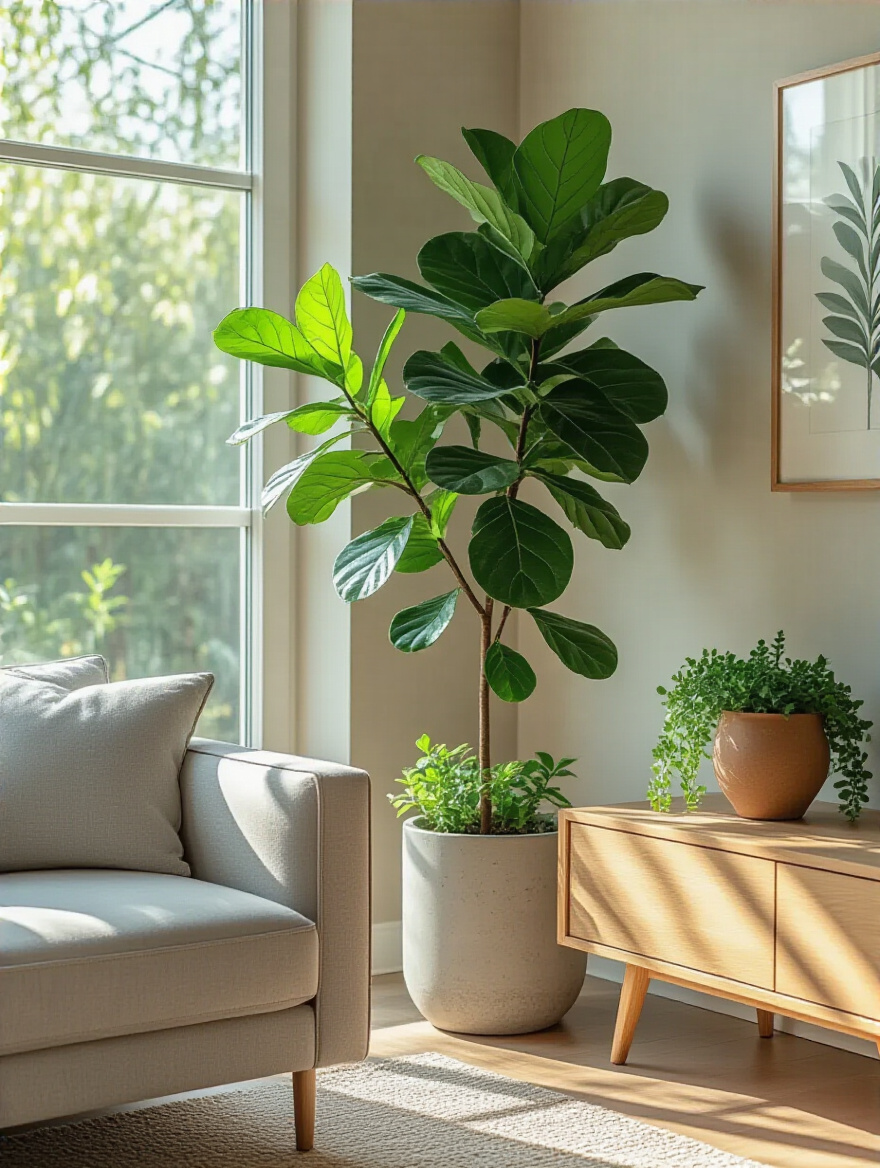
Plants are like living art. They break up all the straight lines and geometric shapes of modern decor with their organic curves. And let’s not forget the well-being benefits—they purify the air and have been proven to reduce stress. You don’t need a jungle, either. A few well-placed plants can make a world of difference, making the room feel healthier, more vibrant, and more connected to the outdoors.
From living art, we turn to the art you hang on your walls.
Art is incredibly personal, but in the context of design, its job is to be part of a team. It should complement the room, not scream over everything else. The mistake I see most often is choosing art that’s the wrong scale—either a tiny piece floating on a huge wall, or a massive piece that completely overwhelms the furniture.
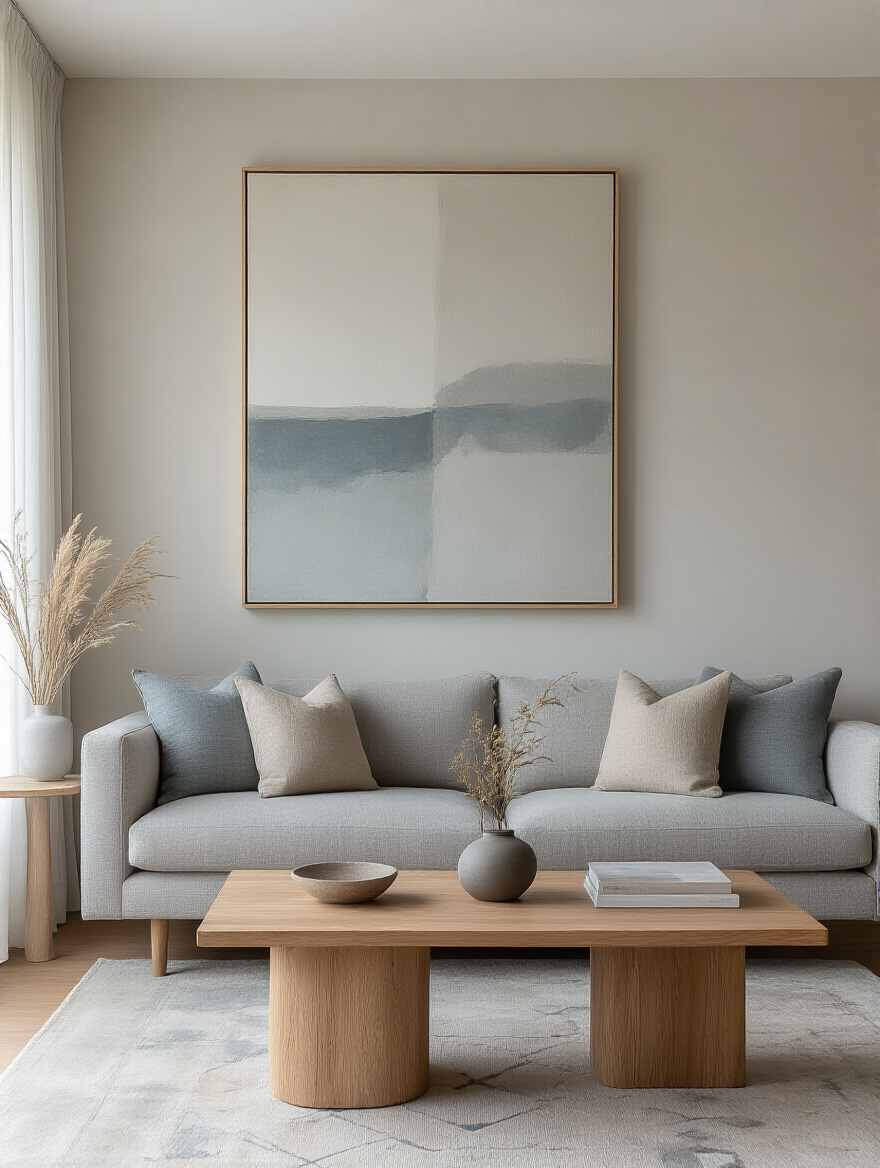
Before you buy art, think about the color palette and mood of your room. Are you looking for a calm, serene piece that echoes the neutral tones of your space? Or are you looking for a single, powerful pop of color that serves as your 10% accent? I once had a client with a beautiful, calming blue living room. They hung a gigantic, aggressive red abstract painting over the sofa, and it instantly made the entire room feel anxious. The art was great, but it was fighting the room. The goal is harmony.
The same principle of harmony applies to the things you put on your shelves.
Your shelves are not a storage unit; they are a gallery for a few, carefully chosen objects. This is the “less is more” principle in action. A cluttered shelf creates visual noise and stress. A curated shelf tells a story and provides a point of calm visual interest. So, edit, edit, edit.
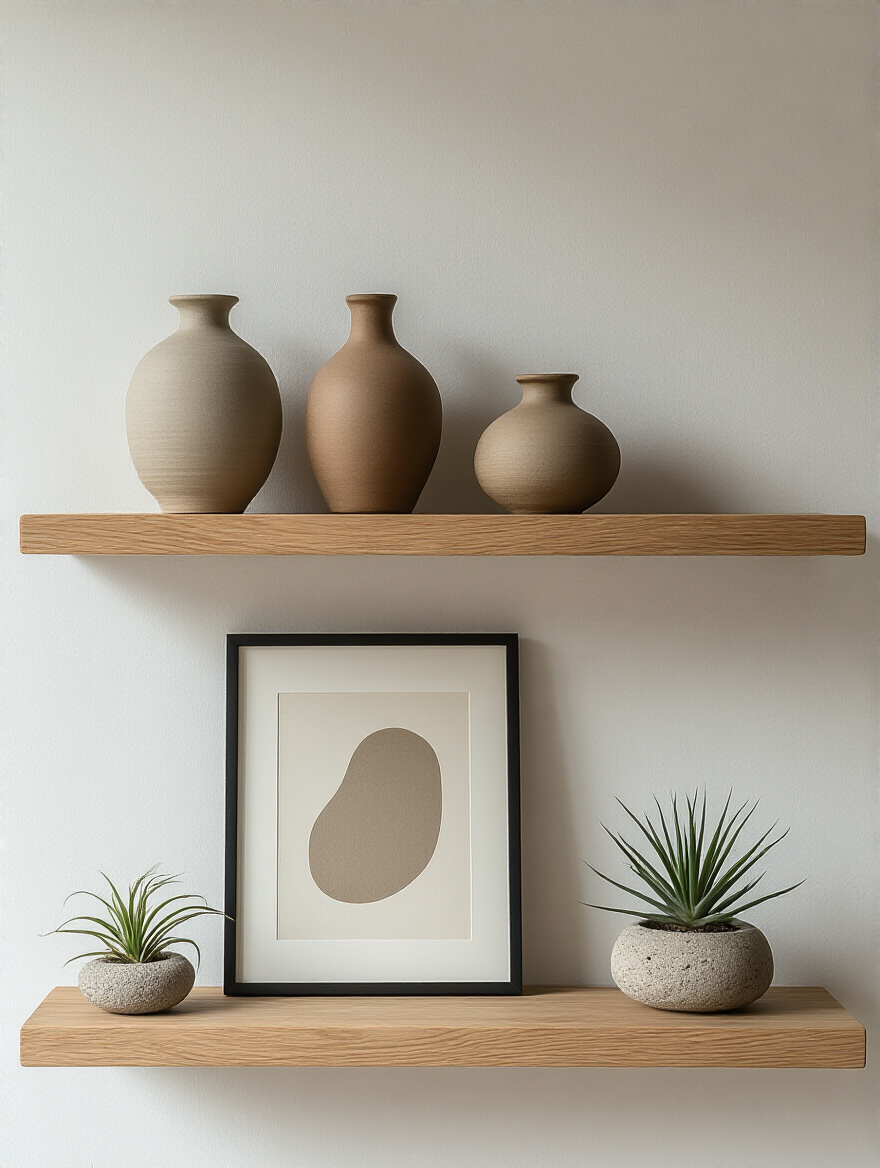
Group items in threes or fives—odd numbers are always more pleasing to the eye. Vary the height and texture of the objects. A tall ceramic vase, a short stack of books, and a small metal sculpture. Most importantly, leave empty space. This “negative space” is what gives the objects on display their power. It allows them to be seen and appreciated. Your shelves should be a highlight reel of your favorite things, not a comprehensive inventory.
We’re in the final stretch now. These are the finishing touches that add layers of comfort and clever design tricks to make your space feel complete, polished, and even bigger than it is.
If your furniture is the main course, pillows and throws are the spice. They are the easiest and most inexpensive way to inject personality, color, and texture into your living room. They are the quick-change artists of interior design. You can completely change the vibe of your room just by swapping them out seasonally.
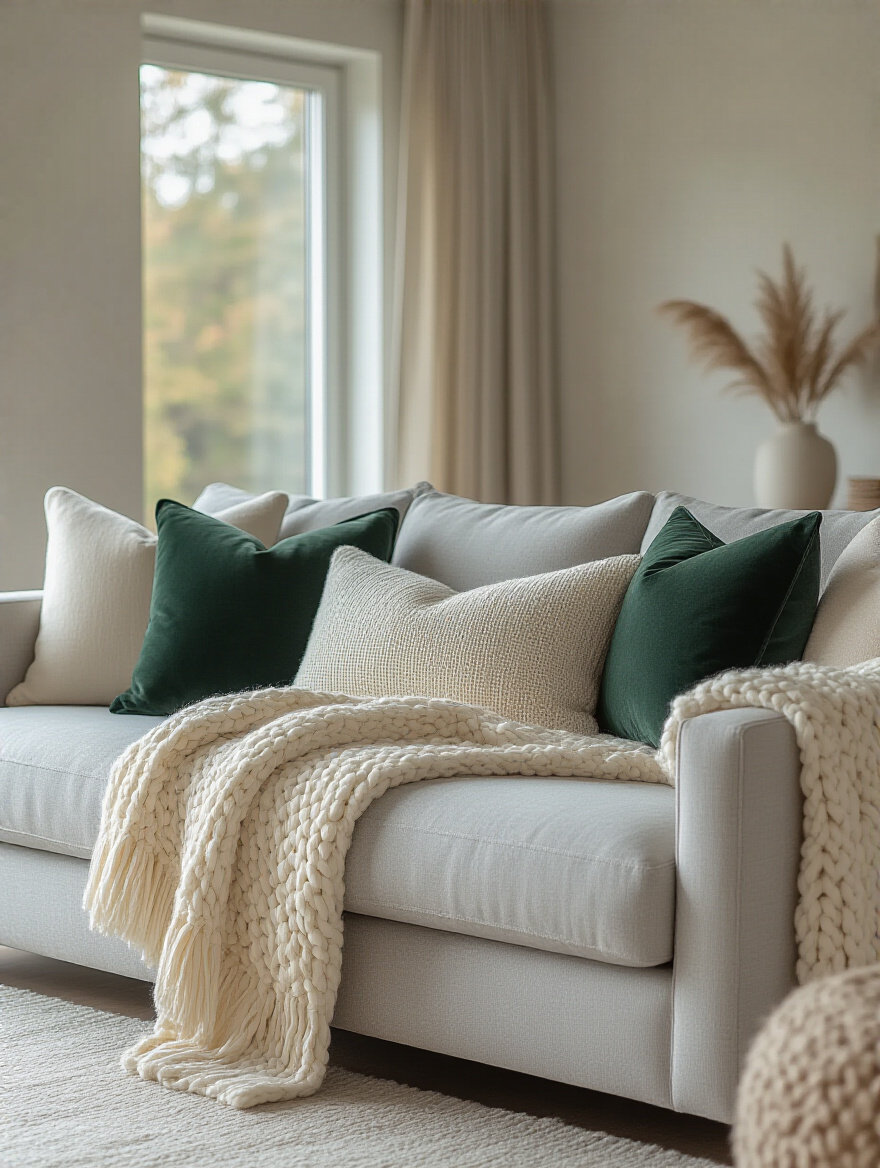
The trick is to think like a stylist. Don’t just get two matching pillows from the same set as your sofa. That’s a missed opportunity. Mix textures: velvet, linen, faux fur, knit. Vary the sizes and shapes—a large square, a smaller square, and a rectangular lumbar pillow create a much more dynamic arrangement. A casually draped throw blanket instantly makes a sofa look more inviting and comfortable. This is how you make your modern room feel like a cozy, welcoming home.
Next up, my favorite magic trick for any room.
Mirrors are miracle workers. They are the ultimate hack for making a room feel larger and brighter. A large, well-placed mirror acts like another window, reflecting light and the view, creating an illusion of depth that can visually double the size of a space.
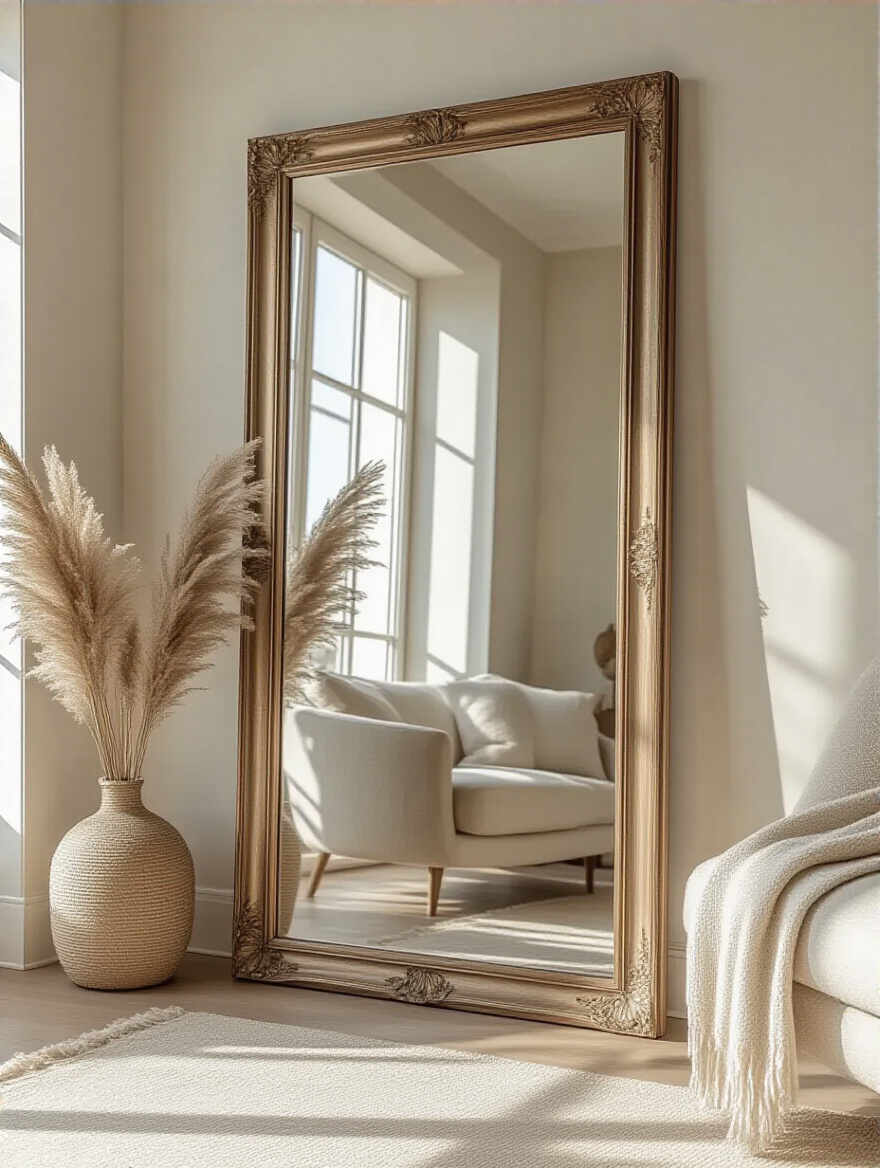
But here’s the critical rule: Be mindful of what you are reflecting. I’ve seen people hang a beautiful mirror that perfectly reflects a messy pile of clutter or a blank, boring wall. That’s a total fail. Position your mirror to reflect a window, a beautiful piece of art, or an open doorway to another room. This strategic placement is what unlocks its full potential as a space-expanding, light-multiplying tool.
Now we’re moving into the pro-level strategies. This is how you take a well-designed room and elevate it with seamless technology and a deep respect for the unique character of your home, all while avoiding the traps that can make a space feel dated.
Here’s my sweet spot. Smart home tech is incredible, but it should be invisible. The goal is technology that serves you without demanding your attention. It’s not about having a mess of gadgets, screens, and cables everywhere. True modern luxury is when technology just works, effortlessly, in the background.
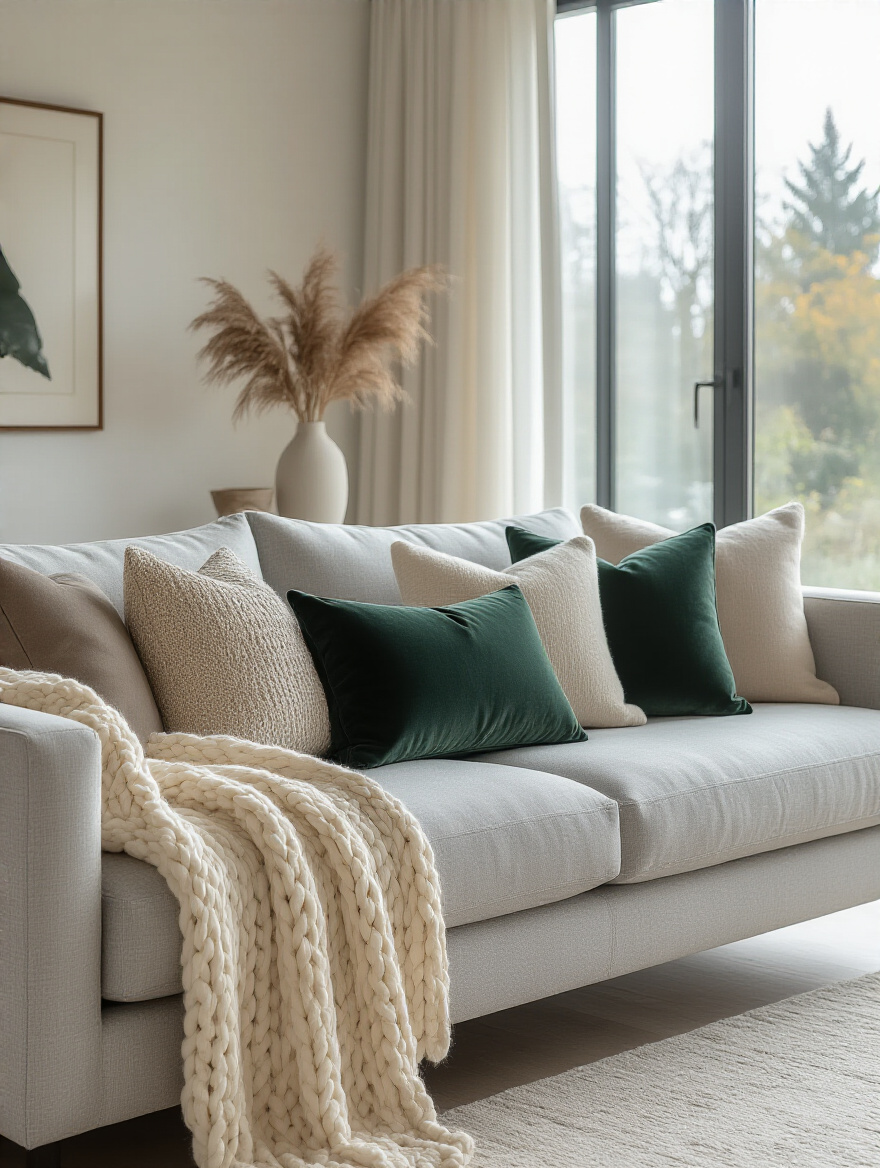
Think of smart blinds that adjust automatically to let in the perfect amount of light throughout the day, without you ever touching them. Recessed smart lighting that shifts its color temperature from a cool, focus-enhancing light in the afternoon to a warm, relaxing glow in the evening. Or a sleek, minimalist smart speaker that fills the room with music from a voice command. The tech is hidden within the design, enhancing your life while keeping the aesthetic clean and serene. That’s the future.
Just as you integrate new tech, you have to honor what’s already there.
Every room has its own built-in assets. Maybe you have gorgeous high ceilings, a huge picture window, or a classic fireplace. Don’t fight these features—make them the hero of the room! These are architectural gifts, and your design should celebrate them.
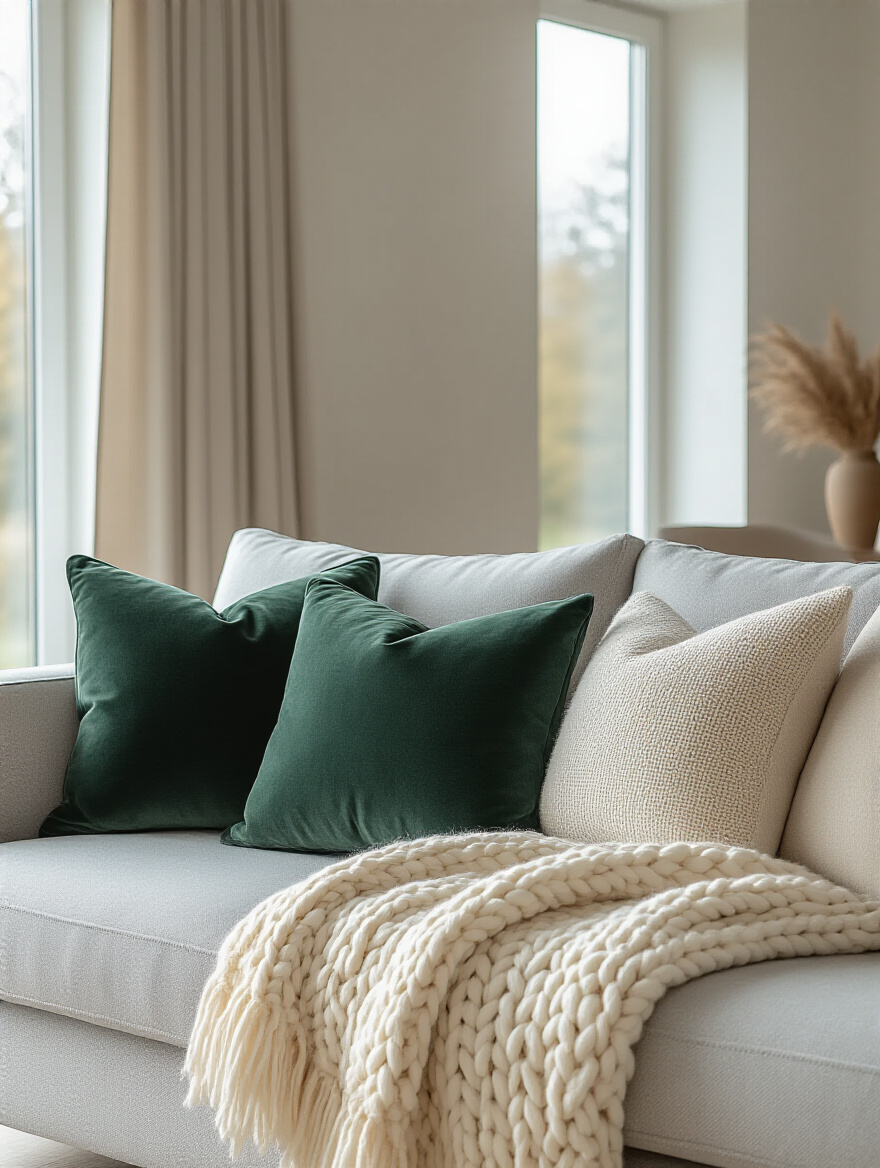
If you have high ceilings, draw the eye up with floor-to-ceiling curtains or a tall, dramatic light fixture. If you have a beautiful window, don’t crowd it with heavy furniture; frame the view. A dated fireplace can be given a modern facelift with new tile or a coat of paint, turning it into a stunning focal point. Working with your home’s architecture, instead of against it, creates a sense of harmony that you can’t get from just buying new stuff.
And speaking of buying new stuff, let’s talk about the biggest mistake people make.
The fastest way to create a boring, lifeless room is to buy a matching five-piece furniture set. A room needs a little bit of tension to be interesting. It needs pieces from different sources, with different textures and maybe even from different eras, to feel curated and personal. Everything shouldn’t match; it should go. There’s a big difference.
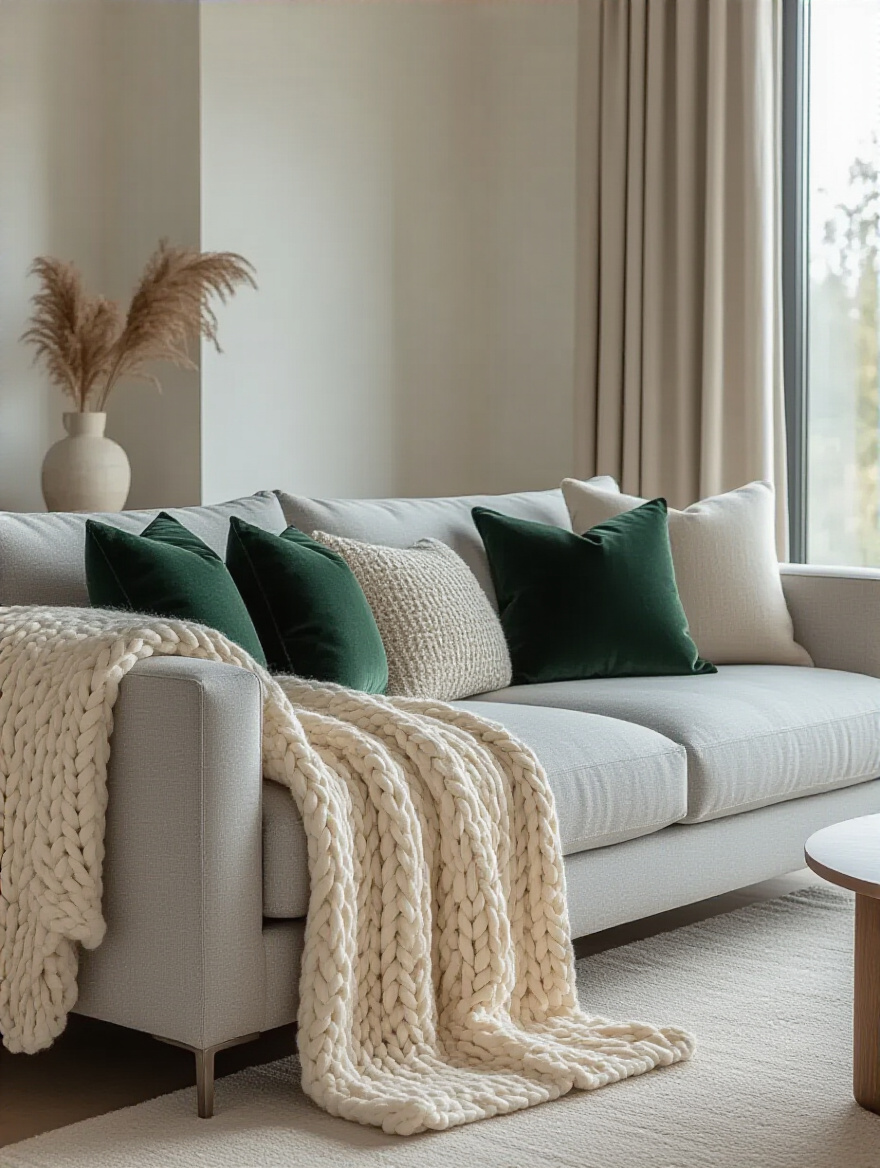
The other cardinal sin is over-accessorizing. Just because you have a surface doesn’t mean you need to put something on it. Negative space is your friend. It gives the eye a place to rest and makes the few, special items you do choose to display feel more important. Curation is about editing. When it comes to accessories, always choose quality over quantity.
Ultimately, this is all about making the space feel like you.
A modern living room shouldn’t feel like a sterile showroom. It’s your home! It needs to tell your story. This is where your curated keepsakes come in. That small sculpture you bought on a memorable trip, a framed photo that makes you smile, a stack of books that shaped who you are—these are the things that give a room its soul.
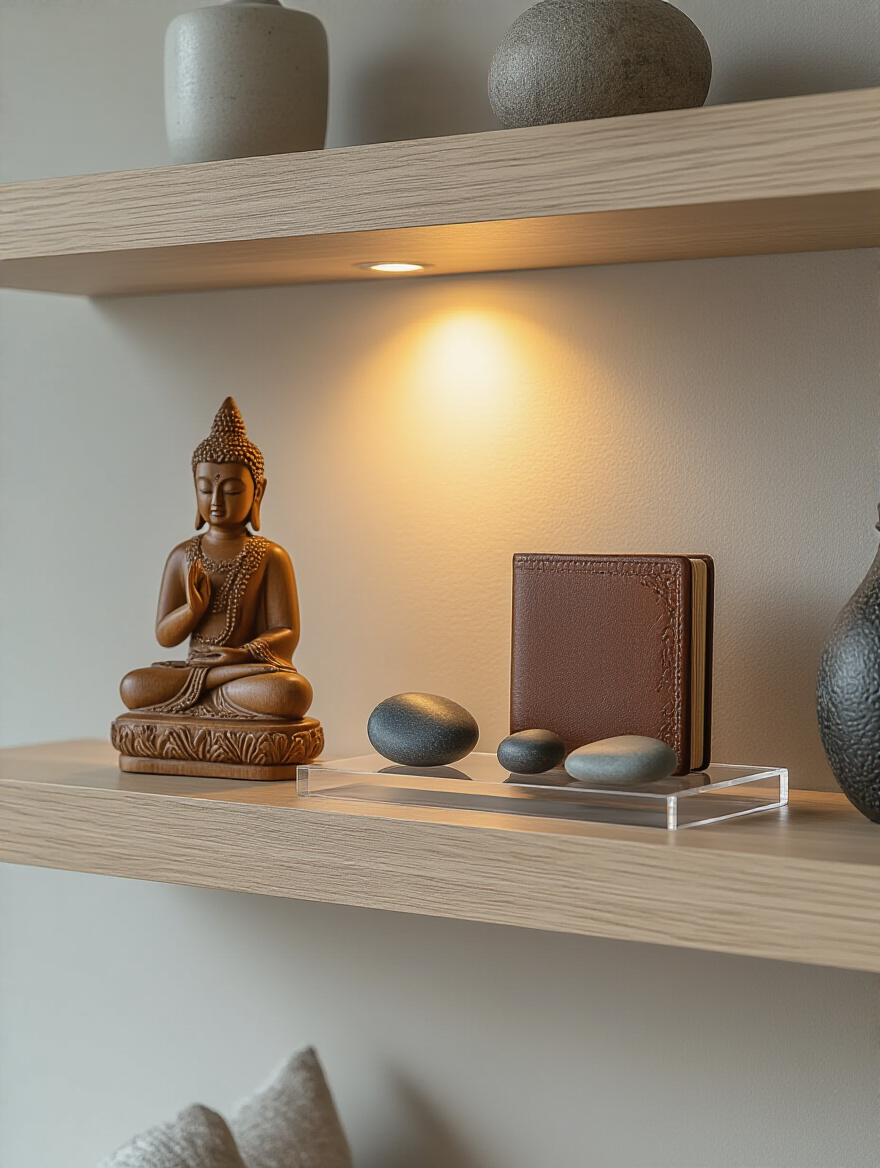
The key word here is “curated.” This isn’t about displaying every trinket you’ve ever owned. It’s about choosing a few meaningful items and giving them a place of honor. These personal touches are what transform a well-designed space into a cherished home. They’re conversation starters. They’re daily reminders of your journey. They are what make the space uniquely yours.
We’re at the final, crucial step. It’s about pulling everything together with a mindset that ensures your beautiful, functional, and personal living room doesn’t just look good today, but remains stylish and relevant for years to come.
Future-proofing your living room means resisting the urge to jump on every micro-trend that pops up on social media. It’s about building a foundation of timeless, high-quality pieces that will still look fantastic in ten years. Invest in a classic sofa shape, solid wood furniture, and a neutral color palette for your major items.
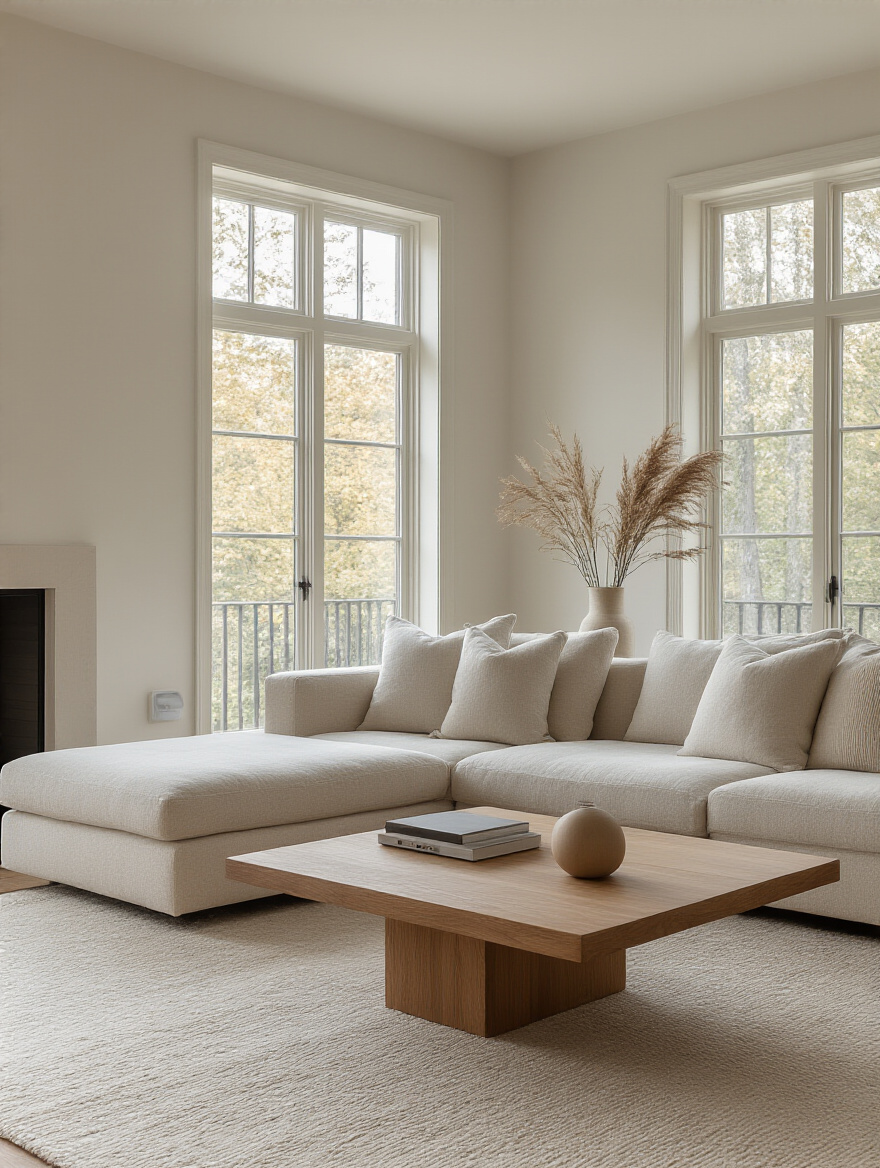
This is not only more sustainable, but it’s also smarter financially. This timeless foundation gives you the freedom to play with trends in small, inexpensive ways—a trendy pillow cover, a new vase, a piece of art. You can keep your room feeling fresh and current without having to do a major, costly overhaul every few years. It’s the ultimate combination of style, sustainability, and smart design.
So there you have it. The real story, not the corporate speak. It all boils down to this: plan thoughtfully, invest in quality foundational pieces, and curate the details that make the space uniquely yours. A truly modern living room isn’t just about how it looks; it’s about how it makes you feel and how it works for your real life. It should be your sanctuary—a place that’s smart, comfortable, and a true reflection of you.
Don’t let this just be another article you read. Pick one thing from this list that resonated with you—maybe it’s decluttering your shelves or buying a rug that actually fits—and do it this weekend. That one small step is the start of transforming your space. You have the tools, you have the vision. Now go create a living room you absolutely love coming home to.